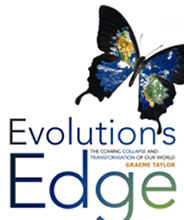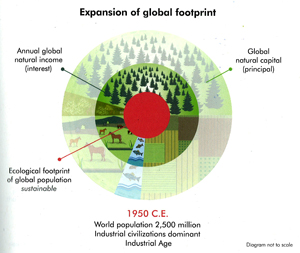Evolution's Edge
by Graeme Taylor
 Evolution's Edge is a story of transformation. A story of why we are doomed to fail unless we have enough courage to save life on Earth and our children's futures.
Evolution's Edge is a story of transformation. A story of why we are doomed to fail unless we have enough courage to save life on Earth and our children's futures.
Taylor is clearly a rare polyglot. Evolution's Edge glides between disciplines not like a textbook bound to remain on the shelf but as a vessel that you can return to time and again to grasp the subtleties of our interconnected planet.
It is a story of resources, technology, and nature, but more importantly it is a story of people and how we came to be in the here and now. Taylor's central thesis uses societal evolution - the process by which societies reorganise themselves in more complex forms with new capabilities - to explain "why the next level of civilisation has already begun to emerge."
It is beautifully illustrated by Fereshteh M. Sadeghi and in fact if I was to have one small criticism it would be that there are not enough illustrations such is their simplicity in contributing to the ideas.
Many of the ideas in Evolution's Edge will not be new to you. But they may become the string that allows you to tie disparate trains of thought together.
It may sound strange to be reviewing this on the pages of a website dedicated to plant conservation, but there are lessons and thoughts in here that can fundamentally improve how we interact with the planet and each other. By that basis it is as useful a tool in the armory of anyone interested in the intelligent curation of the natural world as any other.

Evolution’s Edge won the Gold Medal for the book “Most likely to save the planet” at the 2009 Independent Publisher’s Awards (the world’s largest book competition).
It was also a finalist in Foreword Magazine’s competition for “Environmental Book of the Year” and was shortlisted in the Queensland Premier’s Literary Awards for “Science Writer”.
Reviewed by Dan Ryan, Feb 2009
Buy the book from Amazon UK and Amazon USA
Here's an excerpt from Introduction: The Evolutionary Challenge
At the cutting edge
At the cutting edge of evolution, changing conditions and competition leave few options: species and societies either evolve or die off. Evolutionary change results when either random mutation (in plants and animals) or conscious invention (in human societies) produces new structures with new capabilities. The need for environmental relevance means that useful changes are preserved, while useless changes disappear. At each new biological and social stage new and more complex forms and functions emerge.
We are the products of many successful evolutionary transformations: inorganic evolution from subatomic particles to complex molecules; biological evolution from single-cell organisms to humans; social evolution from hunter-gatherer societies to industrial civilizations. Now we are in the middle of another evolutionary leap. However, our long history does not guarantee future success: most of the species and most of the civilizations that have ever existed on earth are extinct. Because industrial civilization is rapidly degrading the global environment, we have reached a critical point where the survival of humanity is threatened.
The problem is that limitless expansion is not possible on a finite planet. The danger is that our growth-based global system will collapse as critical resources become scarce and major ecosystems fail. The hope is that new ideas, values and technologies will enable us to avoid disaster and create a better world. Humanity has no choice: if global civilization is to survive, it must evolve into a completely new type of societal system. A consumer society cannot be transformed into a conserver society without structural change.
From tipping points to transformation
In front of us are both an immense challenge and a wonderful opportunity. The challenge is to avoid the catastrophic collapse of our natural and social worlds. The opportunity is to finally end humanity’s ancient addiction to war and greed and to create a peaceful and healthy civilization. This is possible because the same forces that are driving us to self-destruction are creating the conditions for constructive change.
Human societies have been evolving for more than 200,000 years. Nomadic families of hunter-gatherers armed with stone spears have developed into industrialized nations armed with nuclear missiles. In the process, occasional contacts between isolated bands have developed into constant exchanges among international networks. Globalization marks the beginning of a tremendous shift past tribal and national boundaries towards a planetary civilization. But it also marks the end of unexplored frontiers and the end of major resource discoveries. With the shrinking of time and space, our species has begun to realize that it lives on a finite planet with limited resources.
Globalization is triggering a profound shift in human consciousness. On one hand we are being forced to realize that we cannot do anything we want — the price of continuing to exploit nature and each other will be our own destruction. On the other hand, we are learning that our differences are less important than our commonalities — because we are all humans, if our species succeeds, our children and grandchildren will lead happy lives; if it fails, they will inhabit a dying world.
This is a time when we can — and must — make a great turning. The coming global crisis is a critical but inevitable part of the social evolution of our species. Our species has not failed — rather we risk being the victims of our own success. The Industrial Age has not been an evolutionary error, but a necessary stage in human development. It has encouraged the growth of science and technology; it has given most people better and longer lives. However, these benefits have come with enormous environmental and social costs, and the industrial system has now outlived its usefulness.
The continuing development of both destructive and constructive capabilities creates two trends:
• The dominant trend towards collapse — unsustainable consumption and environmental destruction.
• The emerging trend towards transformation — sustainable ideas, values and technologies.
These two trends are the major forces shaping the world today. There is no guarantee that all the necessary elements of a sustainable system will develop quickly enough to prevent irreversible environmental and social damage. Major evolutionary transformations only occur after a critical number of useful paradigm changing developments (functional mutations) have taken place within a biological or social system. If these new system components are compatible, their interactions can begin to change the form and function of the entire system.
All of the key social and technological components of a sustainable system will have to be present before it will be possible for our consumer society to transform itself into a conserver society. For this reason we need to actively support their development. In order to do this we need to understand not only the evolutionary process but also the requirements of a sustainable system.